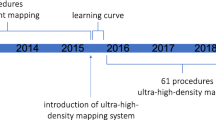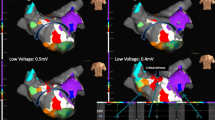Abstract
Ultra-high-density mapping allows very accurate characterization of circuits/mechanisms in atrial tachycardia (AT). Whether these advantages will translate into a better procedural or long-term clinical outcome is unknown. Sixty consecutive AT ablation procedures using ultra-high-density mapping (Rhythmia™, group 1) were retrospectively compared to 60 consecutive procedures using standard high-density mapping (Carto/NavX™, group 2) (total 209 AT, 79% left AT). A higher number of maps were performed in group 1 (4.8 ± 2.5 vs 3.2 ± 1.7, p = 0.0001) with similar acquisition duration (12 ± 5 vs 13 ± 6 min per map, p = ns), although with a greater number of activation points (10,543 ± 5854 vs 689 ± 1827 per map, p < 0.0001). AT location remained undetermined in 5 AT in group 1 vs 10 (p = 0.1). Mechanism remained undetermined in 5 AT from group 1 vs 11 (p = 0.06). Acute complete success was achieved in 77%, in both groups. At 1-year follow-up, AT recurred in 37% in group 1 vs 50% in group 2 (p = 0.046). There are less long-term recurrences after AT ablation using ultra-high-density mapping system compared to standard high-density 3D mapping, possibly because of a better comprehensive approach of AT mechanisms.




Similar content being viewed by others
References
Page RL, Joglar JA, Caldwell MA, Calkins H, Conti JB, Deal BJ, Estes NAM 3rd, Field ME, Goldberger ZD, Hammill SC, Indik JH, Lindsay BD, Olshansky B, Russo AM, Shen WK, Tracy CM, Al-Khatib SM (2016) 2015 ACC/AHA/HRS Guideline for the Management of Adult Patients With Supraventricular Tachycardia: A Report of the American College of Cardiology/American Heart Association Task Force on Clinical Practice Guidelines and the Heart Rhythm Society. J Am Coll Cardiol 67:e27–e115
Veenhuyzen GD, Knecht S, O’Neill MD, Phil D, Wright M, Nault I, Weerasooriya R, Miyazaki S, Sacher F, Hocini M, Jaïs P, Haïssaguerre M (2009) Atrial tachycardias encountered during and after catheter ablation for atrial fibrillation: part I: classification, incidence, management. Pacing Clin Electrophysiol 32:393–398
Jaïs P, Shah DC, Haïssaguerre M, Hocini M, Peng JT, Takahashi A, Garrigue S, Le Métayer P, Clémenty J (2000) Mapping and ablation of left atrial flutters. Circulation 101:2928–2934
Sporton SC, Earley MJ, Nathan AW, Schilling RJ (2004) Electroanatomic versus fluoroscopic mapping for catheter ablation procedures: a prospective randomized study. J Cardiovasc Electrophysiol 15:310–315
Baker BM, Lindsay BD, Bromberg BI, Frazier DW, Cain ME, Smith JM (1996) Catheter ablation of clinical intra atrial reentrant tachycardias resulting from previous atrial surgery: localizing and transecting the critical isthmus. J Am Coll Cardiol 28:411–417
Nakagawa H, Shah N, Matsudaira K, Overholt E, Chandrasekaran K, Beckman KJ, Spector P, Calame JD, Rao A, Hasdemir C, Otomo K, Wang Z, Lazzara R, Jackman WM (2001) Characterization of reentrant circuit in macro reentrant right atrial tachycardia after surgical repair of congenital heart disease: isolated channels between scars allow “focal” ablation. Circulation 103:699–709
Akar JG, Kok LC, Haines DE, DiMarco JP, Mounsey JP (2001) Coexistence of type I atrial flutter and intra-atrial re-entrant tachycardia in patients with surgically corrected congenital heart disease. J Am Coll Cardiol 38:377–384
Triedman JK, Bergau DM, Saul JP, Epstein MR, Walsh EP (1997) Efficacy of radio frequency ablation for control of intra atrial reentrant tachycardia in patients with congenital heart disease. J Am Coll Cardiol 30:1032–1038
Chan DP, Van Hare GF, Mackall JA, Carlson MD, Waldo AL (2000) Importance of atrial flutter isthmus in post operative intra-atrial reentrant tachycardia. Circulation 102:1283–1289
Ferrero de Loma-Osorio Á, Díaz-Infante E, Macías Gallego A, Spanish Catheter Ablation Registry Collaborators (2013) Spanish Catheter Ablation Registry. 12th Official Report of the Spanish Society of Cardiology Working Group on Electrophysiology and Arrhythmias (2012). Rev Esp Cardiol (Engl Ed) 66:983–992
Stevenson IH, Kistler PM, Spence SJ, Vohra JK, Sparks PB, Morton JB, Kalman JM (2005) Scar-related right atrial macro-reentrant tachycardia in patients without prior atrial surgery: electro anatomic characterization and ablation outcome. Heart Rhythm 2:594–601
Esato M, Hindricks G, Sommer P, Arya A, Gaspar T, Bode K, Bollmann A, Wetzel U, Hilbert S, Kircher S, Eitel C, Piorkowski C (2009) Color-coded threedimensional entrainment mapping for analysis and treatment of atrial macroreentrant tachycardia. Heart Rhythm 6:349–358
Huo Y, Schoenbauer R, Richter S, Rolf S, Sommer P, Arya A, Rastan A, Doll N, Mohr FW, Hindricks G, Piorkowski C, Gaspar T (2014) Atrial arrhythmias following surgical AF ablation: electrophysiological findings, ablation strategies, and clinical outcome. J Cardiovasc Electrophysiol 25:725–738
Coffey JO, d’Avila A, Dukkipati S, Danik SB, Gangireddy SR, Koruth JS, Miller MA, Sager SJ, Eggert CA, Reddy VY (2013) Catheter ablation of scar-related atypical atrial flutter. Europace 15:414–419
Nakagawa H, Ikeda A, Sharma T, Lazzara R, Jackman WM (2012) Rapid high resolution electroanatomical mapping: evaluation of a new system in a canine atrial linear lesion model. Circ Arrhythm Electrophysiol 5:417–424
Latcu DG, Bun SS, Viera F, Delassi T, El Jamili M, Al Amoura A, Saoudi N (2017) Selection of critical isthmus in scar-related atrial tachycardia using a new automated ultrahigh resolution mapping system. Circ Arrhythm Electrophysiol 10:e004510
Anter E, McElderry TH, Contreras-Valdes FM, Li J, Tung P, Leshem E, Haffajee CI, Nakagawa H, Josephson ME (2016) Evaluation of a novel high-resolution mapping technology for ablation of recurrent scar-related atrial tachycardias. Heart Rhythm 13:2048–2055
Khongphatthanayothin A, Kosar E, Nademanee K (2000) Nonfluoroscopic three-dimensional mapping for arrhythmia ablation: tool or toy? J Cardiovasc Electrophysiol 11:239–244
Khairy P, Van Hare GF, Balaji S, Berul CI, Cecchin F, Cohen MI, Daniels CJ, Deal BJ, Dearani JA, Groot Nd, Dubin AM, Harris L, Janousek J, Kanter RJ, Karpawich PP, Perry JC, Seslar SP, Shah MJ, Silka MJ, Triedman JK, Walsh EP, Warnes CA (2014) PACES/HRS expert consensus statement on the recognition and management of arrhythmias in adult congenital heart disease: developed in partnership between the Pediatric and Congenital Electrophysiology Society (PACES) and the Heart Rhythm Society (HRS). Can J Cardiol 30:e1–e63
Bun SS, Delassi T, Latcu DG, El Jamili M, Ayari A, Errahmouni A, Berte B, Saoudi N (2018) A comparison between multipolar mapping and conventional mapping of atrial tachycardias in the context of atrial fibrillation ablation. Arch Cardiovasc Dis 111:33–40
Lin H, Chen YH, Hou JW, Lu ZY, Xiang Y, Li YG (2017) Role of contact force-guided radiofrequency catheter ablation for treatment of atrial fibrillation: a systematic review and meta-analysis. J Cardiovasc Electrophysiol 28:994–1005
Rottner L, Metzner A, Ouyang F, Heeger C, Hayashi K, Fink T, Lemes C, Mathew S, Maurer T, Reissmann B, Rexha E, Riedl J, Saguner AM, Santoro F, Kuck KH, Sohns C (2017) Direct comparison of point-by-point and rapid ultra-high-resolution electroanatomical mapping in patients scheduled for ablation of atrial fibrillation. J Cardiovasc Electrophysiol 28:289–297
Segerson NM, Lynch B, Mozes J, Marks MM, Noonan DK, Gordon D, Jais P, Daccarett M (2018) High-density mapping and ablation of concealed low-voltage activity within pulmonary vein antra results in improved freedom from atrial fibrillation compared to pulmonary vein isolation alone. Heart Rhythm. https://doi.org/10.1016/j.hrthm.2018.04.035
Author information
Authors and Affiliations
Corresponding author
Ethics declarations
Conflict of interest
None except for SC who is employed by Boston Scientific.
Additional information
Philippe Maury and Laure Champ-Rigot share first authorship.
Rights and permissions
About this article
Cite this article
Maury, P., Champ-Rigot, L., Rollin, A. et al. Comparison between novel and standard high-density 3D electro-anatomical mapping systems for ablation of atrial tachycardia. Heart Vessels 34, 801–808 (2019). https://doi.org/10.1007/s00380-018-1307-1
Received:
Accepted:
Published:
Issue Date:
DOI: https://doi.org/10.1007/s00380-018-1307-1




